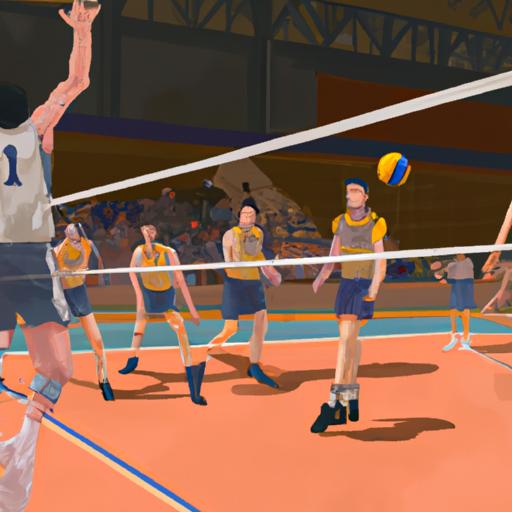Has your shoulder been hurting after long hours on the court playing volleyball? You’re not alone.
Shoulder pain from playing volleyball is a common occurrence.
Fortunately, there are steps you can take to reduce the pain and protect yourself from further injury.
In this article, we’ll cover the causes of shoulder pain from playing volleyball, the symptoms to look out for, and the steps you can take to reduce the pain and avoid further injury.
With these expert tips, you can get back to playing volleyball without any worries.
Table of Contents
Short Answer
If your shoulder hurts from playing volleyball, the first thing you should do is rest and avoid further activity that puts strain on the shoulder.
Make sure to apply ice to the area for 15 minutes at a time to reduce swelling and inflammation.
You should also consider taking an over-the-counter anti-inflammatory medication.
If the pain persists, talk to your doctor about other treatment options.
What Makes Shoulder Pain from Playing Volleyball Common?
Shoulder pain from playing volleyball is a common issue for players of all experience levels.
This is because the repetitive motion of serving and hitting the ball can lead to overuse injuries of the shoulder.
In addition, the use of the shoulder joint to generate power when hitting the ball can cause the muscles and tendons to become strained.
This can lead to pain, inflammation, and decreased range of motion.
Furthermore, the shoulder joint is complicated and requires a delicate balance of strength, stability, and flexibility in order to function properly.
When this balance is disrupted, shoulder pain can arise.
Poor technique when serving or hitting the ball can also lead to shoulder pain due to incorrect posture or lack of power.
All of these factors can lead to shoulder pain that can be debilitating and prevent a player from enjoying the game.
What Are the Symptoms of Shoulder Pain?

Shoulder pain from volleyball can come in many forms, including general discomfort, a sharp or burning pain, tenderness, and/or stiffness.
It is also common to experience a decrease in range of motion in the affected shoulder, as well as possible swelling.
Depending on the severity of the injury, it is possible to also experience shooting pains that may radiate down the arm.
In some cases, the pain may be accompanied by numbness or tingling, and the affected area may also be warm to the touch.
It is important to note that shoulder pain can also be caused by other conditions, such as bursitis, tendinitis, and impingement syndrome.
Therefore, it is wise to consult a doctor if the pain does not improve with rest and other self-care measures.
How to Avoid Further Injury
If your shoulder hurts from playing volleyball, it is important to take the proper steps to ensure that you are taking care of yourself and avoiding further injury.
While this may seem like a daunting task, there are several steps you can take to help reduce your risk and prevent further injury.
First and foremost, it is essential to rest and avoid any activities that may cause further discomfort.
This may mean taking a few days off from practice or even sitting out of games if necessary.
Taking a break from the sport can help your shoulder heal and prevent any future pain.
Additionally, you can apply ice or a cold compress to the affected area.
This will help reduce any swelling and inflammation, and can provide a soothing sensation for any soreness you may be experiencing.
It is also advisable to take over-the-counter anti-inflammatory medications, such as ibuprofen or naproxen, to help reduce any pain and swelling.
However, it is important to take these medications as directed and not exceed the recommended dosage.
Finally, if the pain persists or gets worse, it is always important to seek medical attention from a qualified healthcare professional.
A doctor or physical therapist can help diagnose the cause of your shoulder pain and provide specific treatments or exercises to help alleviate the discomfort.
By following these steps, you can help to alleviate any pain and prevent further injury.
Taking time to properly rest and care for your shoulder can help you stay healthy and enjoy the sport of volleyball for many years to come.
Resting the Shoulder

When it comes to dealing with shoulder pain caused by volleyball, the first step is to rest the affected shoulder and avoid any activities that may cause further discomfort.
Resting the shoulder gives the muscles and tendons time to heal, reducing the chance of further injury.
During this time, it is important to avoid any activities that require using the shoulder, such as lifting, pushing, or pulling.
Its also important to avoid any activities that involve repetitive motions, such as throwing or swinging a racket.
It is also a good idea to use a sling or brace to immobilize the shoulder and reduce the chance of further injury.
This will help to keep the shoulder in a neutral position and reduce the amount of strain placed on the shoulder.
Additionally, it is important to use proper form when engaging in any activities that might require the use of the shoulder in order to reduce the chance of further injury.
Finally, it is important to get plenty of rest.
This will help the body to heal and ensure that the shoulder is given enough time to recover.
It is also important to reduce any stress that might be placed on the shoulder, such as sitting in an uncomfortable position for long periods of time.
Taking these steps will help to ensure that the shoulder is given enough time to heal and reduce the chance of further injury.
Applying Cold Therapy
Cold therapy is a great way to reduce the pain and swelling associated with an injured shoulder from volleyball.
Applying cold therapy to the injured area can help to reduce inflammation, decrease swelling, and relieve pain.
Cold therapy can be applied in many forms, including ice packs, cold compresses, and even cold gels.
When applying cold therapy, it is important to keep in mind that it is best to keep the cold therapy on the injured area for no longer than 15-20 minutes at a time.
Too much cold therapy can cause tissue damage, so it is important to follow the instructions of a medical professional.
Additionally, it is important to make sure that the affected area is well-protected with a towel or other material, as cold therapy can cause a burning sensation.
When using an ice pack or cold compress, it is important to avoid direct contact with the skin.
This will help to avoid any further irritation or injury.
Additionally, it is important to avoid applying too much pressure to the area, as this can lead to further damage.
Finally, it is important to take breaks between cold therapy sessions.
This will help to reduce the risk of tissue damage and can provide relief to the injured area.
Taking breaks between cold therapy sessions can also help to reduce the risk of further injury.
By following these tips and instructions, those who are dealing with a shoulder injury from volleyball can reduce the pain and swelling associated with the injury and can help to ensure that the injury does not become worse.
Taking the proper steps to care for the injury will help to ensure that the injury heals properly and quickly.
Taking Over-the-Counter Medication

Taking over-the-counter medications is one of the most effective ways to reduce the discomfort associated with a shoulder injury from playing volleyball.
Over-the-counter medications such as ibuprofen and naproxen can help to reduce inflammation and swelling in the affected area, while acetaminophen can help to reduce pain.
It is important to note that these medications should only be taken after consulting with a doctor to ensure that they are safe for your body, as some people may have adverse reactions to certain medications.
Additionally, it is important to take the recommended dosage and follow all of the instructions provided on the medications label.
Be sure to take a break from playing volleyball while taking these medications, as they can make you more prone to injury.
Finally, if the pain persists or gets worse, it is important to seek medical attention.
Seeking Medical Attention
When it comes to dealing with shoulder pain from volleyball, seeking medical attention is an important step.
In some cases, the pain may be caused by a larger underlying issue, such as a tear or sprain.
Visiting a doctor or physical therapist can help to identify the cause of the pain and develop a plan of action to treat it.
This may include physical therapy, rest and rehabilitation exercises, and even surgery if necessary.
Its important to understand that shoulder pain can worsen with improper treatment, so its important to take the necessary steps to ensure it doesnt lead to more serious injury down the line.
Additionally, a doctor or physical therapist can provide advice and guidance on how to better protect your shoulder in the future.
This may include recommending specific exercises or changes to the way you play the game.
For example, they may suggest strengthening the shoulder muscles to reduce the risk of future injury.
Finally, its important to note that not all shoulder pain is caused by playing volleyball.
Its possible that the pain could be due to an unrelated issue, such as a pinched nerve or arthritis.
Visiting a doctor is the only way to accurately identify the cause of the pain and develop an effective treatment plan.
Final Thoughts
Shoulder pain from playing volleyball is a common problem, and it is important to take the proper precautions to avoid further injury.
Resting the shoulder, applying cold therapy, taking over-the-counter medication, and seeking medical attention are all important steps to take to reduce pain and prevent further injury.
By following this advice, you can ensure that your shoulder is healthy and ready for the next game.

